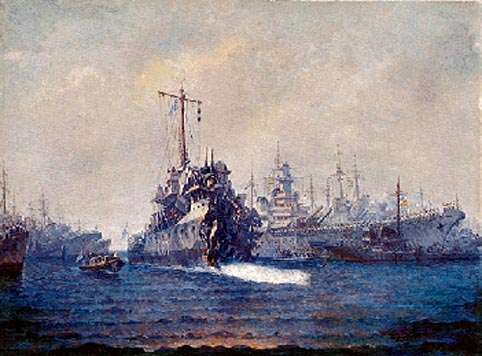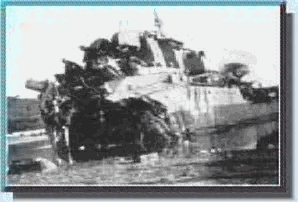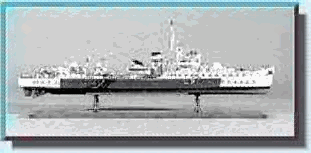
Oil on canvas by A. Kanas, showing the enthusiastic welcome of the destroyer ADRIAS on her arrival at Alexandria on the 6th of December, 1943

It is the night of October 22, 1943. A mine fatally wounds ADRIAS while operating in the Dodecanese area. Yet she will refuse to sink. Under the command of Cdr. I Toumbas she will cover a distance of 700 nautical miles without any cover or any kind of support managing to arrive in Alexandria on Saint Nicola’s day, the patron of sailors.
The reception is unique. The fleets of the Allies are lined up with their crews frantically cheering. The Minister of the Hellenic Navy and the British Admiral escort the gallant ship which true to the Greek naval traditions refused to die.
The destroyer ADRIAS, in the condition she arrived at the port of Gioumoutlzouk in October 23,1943.


Model of the destroyer ADRIAS
One of the most distinguished Greek warships during World War II. She was taken over from the British shipyards on 20th July 1942, by Commander J. Toumbas, her C.O. In January 1943 she sailed to the Mediterranean whilst assisting in the escorting of convoys. Records suggest that on 27th January 1943 she sank the German U-boat, U533, 360 miles off Cape Finisterre, and on 13th February 1943, she sunk or inflicted damage to the U-boat U633. During her service, the ADRIAS took part in escorting many convoys around the Mediterranean Sea, as well as in the landings on Sicily where, during the night between 20th and 21st of July 1943, in a combat with three torpedo-boats of the Italian Navy, she sunk two of them and put the third our of action.
On 10th September 1943, the Italian Fleet, based at Taranto, surrendered to a force of the Allied Fleet, consisting of four destroyers, three British and one Greek, ( ADRIAS). In the campaigns off the Dodecanese Islands in the Aegean on 22nd October 1943, while operating close to the coast of Calymnos, and in company with the British destroyer HURWORTH, she hit a mine, and the explosion cut off the vessels prow and blew the two-gun forward turret over the bridge. HURWORTH, in her effort to assist ADRIAS also hit a mine and immediately sank with a loss of 143 men.
ADRIAS, notwithstanding her condition, tried to rescue survivors of the Hurworth, among them her C.O., and after an unbelievably dangerous passage, managed to reach the nearby coast of Turkey, at Chioumoultzouk, without a prow and with losses of 21 dead and 30 wounded. After great efforts, a certain temporary seaworthiness was attained, and on 1st of December 1943 she started her return trip to Alexandria. Even though all the forepart of the ship, up to the bridge, was missing, she finally managed to arrive on 6th December, 1943. On her entry into port, she was given a glorious reception by ships of Greek and British fleets and all other Allied shipping in port